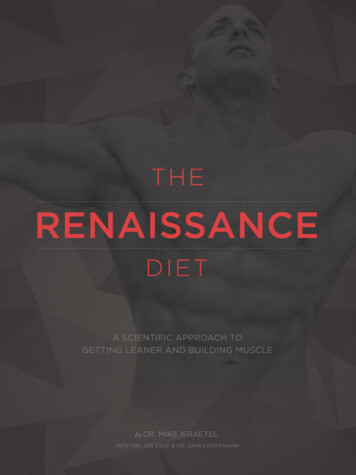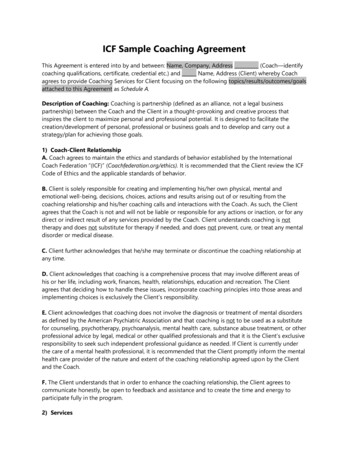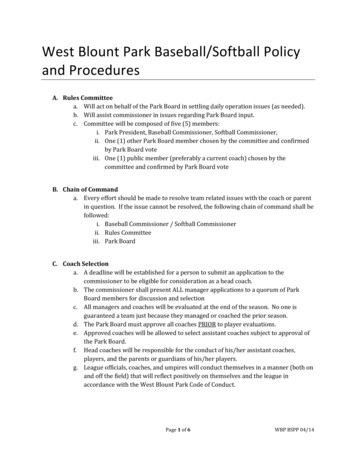
Transcription
SORINEX SUMMER STRONG1
About the AuthorsMike Israetel, PhDMike is a professor of Exercise Science at the University of Central Missouri, where he teaches Exercise Physiology, PersonalTraining, and Advanced Programming for sports and fitness. Mike’s PhD is in Sport Physiology, and he has been a consultant onsports nutrition to the U.S. Olympic Training Site in Johnson City, TN. Mike has coached numerous powerlifters, weightlifters,bodybuilders, and other individuals in both diet and weight training. Originally from Moscow, Russia, Mike is a competitivepowerlifter, bodybuilder, and Brazilian Jiu Jitsu grappler.Jennifer Case, PhD, ATC, CSCSJen is a professor of Exercise Science at the University of Central Missouri, where she teaches Programming for SpecialPopulations, Advanced Nutrition, and Graduate Exercise Metabolism. Jen is a former Femme Fatales MMA World Champion, isthe current IBJJF Master’s World Champion in the purple belt heavyweight division, and is also a black belt in Hawaiian KenpoKarate. Jen’s PhD is in Human Nutrition with main coursework in Nutrition and Performance. Jen is currently a nutrition coachto numerous athletes, with CrossFit athletes as her specialty.
James Hoffmann, PhD, CSCSJames Hoffman is professor or Exercise Science at Temple University in Philadelphia, PA. James earned his PhD in SportPhysiology under Dr. Mike Stone of ETSU, where he focused on the application of sled pushing to sport performanceenhancement in Rugby players. James has coached numerous Rugby players at ETSU as the team’s assistant coach and HeadSport Scientist, where he was also the head strength and conditioning coach and weight room manager. James is a lifetimeathlete, having reached high levels of competition in Rugby, American Football, and Wrestling.About Renaissance PeriodizationRenaissance Periodization is a diet and training consultation company. RP’s consultants (including the authors of this book)write diets and training programs for every kind of client. RP works with athletes trying to reach peak performances,businesspeople that need more energy at work, and people from all walks of life who want to look and feel better. When hefounded RP, CEO Nick Shaw had a vision for a company that delivered the absolute best quality of diet and training to itsclientele. By hiring almost exclusively competitive athletes that are also PhDs in the sport, nutrition, and biological sciences,Nick has assembled a team of consultants that is unrivaled in the fitness industry. In addition to training and diet coaching, theRP team also writes numerous articles and produces instructional videos on diet, training, periodization science, and all mattersinvolving body composition and sport. Visit us at www.renaissanceperiodization.com, email at renperiod@gmail.com.
The Renaissance DietA Scientific Approach to Getting Leaner and Building MuscleChapters:Foreword: A Guide and Starting PointChapter 1: The Dieting Principles and What They MeanChapter 2: Calorie BalanceChapter 3: MacronutrientsChapter 4: Nutrient TimingChapter 5: Food CompositionChapter 6: SupplementsChapter 7: Micronutrients and WaterChapter 8: Nutritional PeriodizationChapter 9: Designing Your DietChapter 10: Common Diet Myths and FadsClosing: Using the Diet Principles to your AdvantageChapter 11: BONUS “Trinity” Powerlifting Templates
Foreword: A Guide and Starting PointThe goal behind the writing of this book is very simple; to bring a scientifically valid, organized approachon dieting for body composition to an intelligent non-specialist audience. The information in this book isalmost entirely derived directly from literature reviews and studies on the individual subjects addressed.This scientific understanding is also filtered through the experience of the authors in working withhundreds of individuals seeking to improve their body compositions including world class weightliftersand powerlifters, bodybuilders, crossfitters, volleyball, rugby, and soccer players, as well as activeprofessionals seeking to improve their look and health. Thus, the tables and charts presented (especiallyin Chapter 9 on designing your own diet) are grounded in research but molded by the authors’experiences as well.Because we’ve cemented our recommendations in hard science, each chapter is followed by anextensive list of references. Deviating from purely academic work, the references are not cited in-textand are mostly books and reviews of the literature, as opposed to individual studies. If you seesomething contentious or so interesting that you want to learn in greater depth about it, our bestrecommendation is to start with one of the referenced textbooks or literature reviews on the matter. Ifyou’re still curious, then taking a look at individual studies (cited within the books and reviews) may be agood next step. We cite the books and reviews here in addition to presenting the actual information fortwo reasons; because we mean this book as a guide to your body composition goals and because thisbook may also serve as a starting point for your journey deep into the intricacies of sport nutrition.Whatever your goals are for reading this book, we hope this information helps. After all, this book waswritten for you.- Mike Israetel
Chapter 1: The Dieting Principles and What they Mean
Almost every successful endeavor has been based on principles. Whether that endeavor is as big asdesigning a car or as relatively less impressive as gaining 5lbs of muscle mass over the course of severalmonths. A properly-functioning car must be based on the principles of internal combustion or electricity,structural design, and computer control, among many others. A diet, similarly, must be based onprinciples that govern body composition, such as calorie balance, macronutrient intake, and nutrienttiming.Just as with designing a car that gets you from one place to another, all of the principles of dieting canbe ranked from the most important and fundamental all the way down to the least. For example, themost important component of the car is the engine. Without it, the car doesn't go anywhere no matterwhat other features are included. Now, the frame and wheels come in at a close second, and the controlsystems right behind, but after that, the details are much less important. Even a car with only a steeringwheel and pedals (no seats or displays) can get you from point A to point B, even though seats andwindscreens highly enhance performance and comfort.With diet design, there are 5 main dieting principles that we can rank from most important to leastimportant. They are, in order:1.) Calorie Balance2.) Macronutrient Amounts3.) Nutrient Timing4.) Food Composition5.) SupplementsCalorie balance is the most important principle of any diet, and has by far the largest effect on dietoutcome. It generally implies that muscle gain is mostly a matter of eating more food, and fat loss ismostly a matter of eating less food, with all other principles adding less and less to the main effect ofcalories. Macronutrient amounts are in second place as far as effect on outcome is concerned. Eatingthe right amounts of protein, carbs, and fats in that order makes an important difference in the quest togetting leaner and more muscular. Nutrient timing comes in at third on the list, but in reality it’s muchless proportionately impactful than the first two principles. It can be an important detail and does makea very meaningful difference to those individuals who compete in strength and physique sports. Foodcomposition comes in at fourth place, and is a very small detail of the dieting process. It’s something tobe considered when the top three priorities are in order, and probably not before then; the sameapplies to supplements. As the name implies, “supplements” are meant to supplement an alreadyeffective diet, and are nowhere near powerful enough to overcome errors in calorie balance, macros, ortiming. When designing a diet, it is imperative to address the bigger picture first. If you do that, youalready have a functional diet, and addressing further details only makes it better. The last thing we'dwant to do is invest all our time into the details first, and have a diet that's highly labor-intensive butdoesn't actually work very well. When building a car, we want a frame with wheels that are connectedto a functioning engine. much later should we concern ourselves with the air conditioning and leatherseats.
So without further ado, let's look at each dieting principle closely and gain understanding of its impacton diet success. In following our priority list, let's take a look at the equivalent of the engine of dieting:calorie balance.
Chapter 2: Calorie Balance
The single most important variable in determining diet success is calorie balance. In Figure 1 below, itsrelative importance to the other diet priorities is visually illustrated.Figure 1: Calorie Balance and the Diet PrioritiesBefore explaining HOW calorie balance impacts diet, let us first define exactly what “calorie balance”means.Defining Calorie Balance PreciselyCalorie balance is the ratio between calories taken in and calories expended in any one individual at anygiven time (usually measured over the course of a week to cancel out most fluctuations). A calorie is aform of energy measurement. Calories can be used (burned) to produce movement and a host of otherbody functions, consumed from food and drinks, where after they can be used to produce energy rightaway, or stored for later use. When not stored as glycogen in the muscles and liver (which fill up quicklyif excess calories are consistently eaten), excess calories are stored mostly in the form of body fat, andunder special circumstances, muscle.There are 3 states of calorie balance, and they are mutually exclusive. That is, it is impossible to be inany more than ONE state at any time.a.) Negative calorie balance is the state in which an individual uses (to produce body maintenance,
recovery, and movement) MORE calories than (s)he consumes. Because the calories being used toproduce energy for these functions are not sufficiently supplied by food intake, stored calories (invarious tissues, such as fat and muscle) must be burned to make up the difference. Because thesecalories come from the breakdown of body tissues, a negative calorie balance ALWAYS results in weightloss. Even though body water alterations may occasionally mask this loss of tissue, it is always going tooccur, with ZERO exceptions so far discovered. The state of negative calorie balance is also known as ahypocaloric diet.b.) Calorie balance is the state in which an individual's intake of calories via food and drink is the same ashis expenditure on activities and body processes. Because an individual that is in calorie balance uses allof the calories they consume for some form of body process, their tissue weight will remain stable. Thiskind of diet is also termed "eucaloric." Now of course intakes and activities on any given day are unlikelyto be exactly eucaloric, since that would require a supra-human level of precision. But, over the courseof weeks and months, eucaloric diets are quite possible. The best indicator of a eucaloric diet? Theperson stays the same weight for weeks on end. This stability in weight reflects a balance betweentissue built and burned and thus demonstrates a eucaloric diet.c.) Positive calorie balance is a state in which more energy is consumed via food and drink than is beingutilized to produce body processes or movement. In this situation, the extra consumed calories areconverted into storage forms, the three most common of which are, in order of their prevalence; fat,muscle, and glycogen. Also known as a hypercaloric diet, this caloric balance will ALWAYS result in tissueweight gain. Well unless the first law of thermodynamics is violated, of course. :)Now that we have the basic terms down, it's time to find out why the heck we're learning them. Iscalorie balance important, and if so, how?How Important Is Calorie Balance?Calorie balance is THE MOST important variable in body composition diet success for a very simplereason: it has the greatest impact on how much muscle you can gain and how much fat you can loseover any period of time. It has this powerful impact because of the straightforward fact that calories viafats, proteins, and carbs, literally COMPOSE body tissues. That is, before any muscle can be built, theraw materials (calories from protein, for example) quite literally need to be there, as nothing more thanbuilding blocks. On the other end, burning fat requires that not enough calories are shuttled into fatcells to keep them the same size as they lose their fat stores when sending them out into the blood.It is possible that the calories burned from fat stores can be used to help build muscle (the protein thatliterally composes muscle must still come from the diet, but we'll get to that in the next chapter). In thatway, muscle can be built and fat burned at the same time, without needing to go into positive caloriebalance for muscle growth or negative calorie balance for fat loss. While this process works well underspecial circumstances, it becomes less and less likely as the person attempting it becomes leaner andmore muscular. That is, the more advanced the athlete, the more calorie balance matters.
If you're lean and muscular enough, your physiology is very offset from what is naturally promoted byyour genes. The body allots some effort into building muscle, and some into burning fat, but as musclegrows to new levels and fat stores shrink, negative-feedback loops attempt to bring the body back intohomeostasis (a stable and sustainable internal environment) by making further muscle building and fatloss very difficult. This physiological state makes muscle gain without an excess of calories very difficult,just as it makes fat loss without a deficit of calories difficult as well.A hypercaloric diet not only provides the raw materials for muscle growth, it also facilitates andactivates muscle growth via a number of hormonal and intracellular signaling mechanisms. Just thesame, a hypocaloric diet not only creates the deficit for fat burning to fill, it also promotes a hormonaland intracellular signaling environment that activates actual fat burning.Research on the importance of calorie balance in relation to changes in muscle and fat stores isoverwhelming, as is the practical experience of almost all lean and muscular athletes (ask a 250lbbodybuilder if they ever had to eat more food than they wanted when gaining muscle, or less food thanthey wanted during fat loss phases).So if calorie balance is so important, how do we determine in which 3 of its states we are in, and when?How to Determine Calorie BalanceIn order to maximize our chances for muscle gain or fat loss, we must know when and how to enter ahypo, hyper, or eucaloric state. This is where some of the best news of this book is: all you need is ascale.We can certainly use a variety of predictive metabolic equations (such as the Harris-Benedict) to get arough estimate of how many calories create a eucaloric state. In fact we have a table in the chapter ondiet design that helps with just that. We can make the process more involved by tracking eating, activity,sleep, stress, and other factors to make the estimate more precise. However, this process can get bothoverwhelmingly complicated and error-prone. For example, what if you sleep in one day, and yourfriend gives you a ride to class, skipping your usual walk. do you have to alter your eating by someprecise amount? How do you plug that into the equations? Equations are a great way to get started withyour calorie balance estimate, but not likely to be of much help in making finer adjustments to acontinuing diet.Luckily, a shortcut can be used to avert most of these needless complexities. We learned above that if adiet is truly hypocaloric, it will ALWAYS result in weight loss over the medium and long term. Ahypercaloric diet always results in gain, and a eucaloric diet always results in a stable bodyweight. Thus,the easiest (and also completely scientifically valid) way to find out which of the three states you are inis to weigh yourself regularly. Because regular body water fluctuations can account for around 2% oftotal bodyweight (and more under special circumstances), using daily weigh-ins to alter dietary and
physical activity patterns may be a bit too frequent. What could be seen as tissue loss may really bewater loss, and thus an estimate of caloric state can be erroneous. Commercial scales themselves haveerrors of a pound or so, which adds to the problem. On the other end, using weight data only collectedonce a week suffers from the same problem. one bad measurement can lead to a miscalculated dietfor a whole week! Thus the best way to track bodyweight seems to be about twice a week.If your twice-weekly bodyweight is oscillating about the same average (holding steady), then you arelikely in a eucaloric state. If it's falling, then you're likely hypocaloric, and if it's rising, then you're likelyhypercaloric. Because body water alterations tend to occur over several days’ time, dietary decisions(whether to increase calories to keep gaining weight, for example) should likely be made only every 2weeks or so. This time period gives us enough data with which to conclude about tissue changes (notwater changes) and thus our caloric state.To put it simply, if your weight is steadily rising, you're hypercaloric. If your weight is stable, you'reeucaloric, and if your weight is steadily falling, you're in a hypocaloric state. It's that easy.Here are three examples of RP clients in the eucaloric, hypercaloric, and hypocaloric states:Graph 1: Eucaloric Diet Weight Measurements
Graph 2: Hypercaloric Diet Weight MeasurementsGraph 3: Hypocaloric Diet Weight Measurements
Calorie Changes for Muscle Gain and Fat lossCalorie balance is the most powerful weapon of both fat loss and muscle gain. So if we endeavor to gainmuscle or lose fat, how hypercaloric or hypocaloric must we get?Both research and practical experience have shown that the optimal rates of tissue change seem to besupported by a 1-2lbs (0.5-1.0kg) per week weight loss or gain. These numbers apply to most individualsunder most circumstances. Exotic situations and individuals (those weighing below 100lbs and far inexcess of 300lbs, for example) may call for different recommendations, to be discussed with a bodycomposition diet coach.In weight loss, rates of loss much slower than 1lb per week tend to be too slow to be an efficient use oftime. After all, why have results in a year that you could have gotten in 6 months? If weight loss isattempted at much greater than 2lbs per week, then lots of fat loss will certainly result, but thepercentage of muscle loss is likely to be higher than desired. Since muscle loss is detrimental toappearance and strength, overly aggressive diets may not be desirable to those seeking to enhance bodycomposition.In weight gain, similar constraints are present as with weight loss. Rates of gain much slower than 1lbper week are simply unnecessarily time consuming. Rates of tissue gain that exceed 2lbs per week aremuch more likely to cause a disproportionate increase in fat mass relative to muscle mass.The study of calorie balance revealed long ago that a pound of tissue was, on average, composed ofaround 3500 calories. That is, to build a pound of extra tissue, around 3500 excess calories must beconsumed above the eucaloric state, and losing a pound of tissue demands a 3500 calorie deficit fromsuch a state.Thus, a good rule of thumb when trying to lose or gain weight is to alter calorie intake (assumingexpenditure stays relatively unchanged) by between 500 and 1000 calories per day (which translates to3500 to 7000 calories, or 1-2lbs of tissue per week). Shoot for around 500 on the slow end of change or1000 to be on the faster end. However, a combination of increased calorie burning in training and areduction in calories eaten seems to be the best approach in most cases. Rarely should hypocaloric statebe generated by diet alone, but rather a combination of diet reduction and exercise increase. In chapter9, we'll cover personal and on-the-fly calorie adjustment to specific goals in more detail.Ok, so we've got our calories covered, what's next? Next in order of importance to diet success aremacronutrients. Let's take a look.
Main Points and Real World Tips- Calorie balance is the ratio of calories burned vs. consumed in food- Of all the diet principles for body composition, calorie balance is the most powerful- Muscle grows the fastest on a hypercaloric diet- Fat burns the fastest on a hypocaloric diet- Bodyweight measurements 2-3 times per week are the best indicators of calorie balance- One to two pounds of weight gain per week is best for adding muscle for most people- One to two pounds of weight loss per week is best for burning fat (but not muscle)Sources and Further Reading:1.) The calorie deficit required to lose a certain amount of 2.) Muscle gains slower for those with high bodyfats, muscle loss faster with those of very low bodyfats.Higher energy deficits lead to more muscle loss as a percent of weight loss, higher energy surpluses leadto higher fat gains as a percent of weight tp://www.ncbi.nlm.nih.gov/pubmed/173675673.) Recommendations for Natural Bodybuilding diet 641354.) General guidelines of intake for strength/power and body composition 395.) ACSM Position Stand on Nutrition and Athletic 25360
Chapter 3: Macronutrients
Macronutrients are second on our list of highest nutritional priorities, as displayed in Figure 2 below:Figure 2: Macronutrients and the Diet PrioritiesThe Three Macronutrients and What They DoOther than alcohol (the intake of which those with body composition goals should be minimizing), allcalories in the diet come from only three macronutrients:- Proteins- Carbohydrates- FatsProteins:For body composition purposes, the most important dietary macronutrient is protein. It is mostimportant for the sole reason that muscle is literally made out of it. If muscle is the car, protein (orrather, the amino acids that compose it) is/are the metal out of which the parts are built. Protein notonly provides the building blocks for muscle growth, it also supplies the amino acids needed to reducemuscle breakdown. In essence, protein both builds new muscle and saves existing muscle from beinglost; both functions are very important in maximizing muscle and minimizing fat.Carbohydrates:For body composition purposes carbs are the most important dietary macronutrient after protein. Ifprotein is like the metal composing car parts, carbs are like the gasoline. In the body composition setting,the primary role of carbs is to provide energy for the hard workouts that build muscle. During high
intensity activities (such as bodybuilding or powerlifting training, for example), the primary fuel used is astored form of carbohydrate called glycogen. Glycogen is stored mostly in the muscles that use it (somestored in the liver as well), and is the dominant contributor of energy to hard workouts. If glycogenlevels are low, hard workouts become increasingly difficult to complete, and almost impossible tocomplete with a consistently high level of performance. But the benefits of carbs don't end withglycogen's role in fueling workouts, they also include:- Supplying the Nervous System with its Preferred FuelCarbs (via blood glucose) are the overwhelmingly preferred fuel of the nervous system. Well-maintainedblood glucose levels resulting from a diet adequate in carbohydrate allow for optimal nervous systemfunction, which means better muscle recruitment, more fatigue resistance, and even more workoutmotivation. Much of the fatigue of long duration training is nervous-system mediated, and actually not aresult of local muscular factors (legs themselves getting tired, for example). Providing the nervoussystem with an adequate source of blood glucose is important towards optimizing workout intensity andduration.- Refueling Glycogen StoresIn addition to glycogen's role as a provider of energy for high intensity workouts, its storage in themuscle plays a role in the regulation of muscle protein synthesis (growth). Low levels of glycogen bythemselves have been shown to feed into a signaling cascade which results in the downregulation ofmuscle growth. That is, just HAVING low muscle glycogen levels, irrespective of training intensity, candamper muscle gain and increase the risk of muscle loss. Since dietary carbohydrate is such a dominantdeterminant of muscle glycogen, having low dietary CHO can have a direct negative impact on musclegrowth.- Secreting InsulinWhen carbohydrates are eaten, insulin is secreted to the proportion of carbohydrate that appears in theblood after digestion (in non-diabetic individuals). The more carbs are eaten, the more insulin issecreted, and vice-versa. Insulin, a hormone secreted by the pancreas, has a profound effect on musclegrowth. That is, when insulin is secreted into the blood and binds to target receptors on the muscle cell'ssurface, a cascade of chemical messengers turn the cell's muscle-growth machinery up to a reflectivelylarge extent. Because of the powerful anabolic effect of insulin, and the fact that carb consumptionsecretes vastly more insulin than the other macronutrients (fats, proteins), carbohydrate consumption isanabolic to muscle tissue. Carbohydrate grows muscle, especially when amino acids from consumedprotein are available as well. Unfortunately insulin is not only anabolic to muscle tissue, but to fat aswell. Thus, too much carbohydrate can cause unwanted fat gain, so there can be too much of a goodthing. Interestingly, the timing of carbohydrate consumption likely has a small effect on the relativefraction of muscle vs. fat gains, and we'll discuss that in the next chapter.Fats:Other than being delicious, dietary fats have several important functions in the body. Essential fats, orfats that cannot be made from converting consumed proteins and carbs, are required for survival. Inaddition, fats serve as the basis of many hormones and intracellular chemical messengers. If dietary fatsdrop too low for too long, some unfortunate hormonal alterations may result (decreases in testosterone,for example). But past meeting a minimum intake, fats don't seem to offer much of a body composition
enhancement benefit. However, they have one very important role in body composition alteration: theywork as a great calorie buffer.Fats have a particular combination of properties which make them a great candidate for adding caloriesto the diet when mass-gaining is the goal:a.)b.)c.)d.)e.)f.)PalatabilityEase of ConsumptionHealth EffectsCalorie DensityPrice per CalorieLow Thermogenic EffectWhen carbohydrate, fat and protein needs are already met (we'll discuss what those needs are later inthis chapter), but our daily calories are not yet filled (imagine needing 5000 calories to gain at the rateyou need, but meeting protein, carb and fat needs for health and performance at 4000), we have achoice to make. We need to figure out which nutrients we are going to eat, and in what proportions, tofill in the extra required calories. We can choose just protein, just carbs, or just fats, or any combinationof 2 or 3 of the macronutrients, but for the reasons listed above and explained below, adding dietary fatis likely the best course of action under most circumstances.a.) Palatability:Fats taste good. As far as most people have determined with their shopping and cooking habits, olive oil,avocado, and grass-fed butter make just about everything taste better. Very few people will complainwhen you add fats to their diet. When people have a choice between an extra spoonful of naturalpeanut butter and an extra whole, dry chicken breast, the choice is usually one-sided.b.) Ease of Consumption:A large variety of foods can be cooked in olive and canola oils, and avocado seems to mix well with justabout any other menu item. Not only are fats delicious, but they're easy to add to the diet. Take yourregular chicken, broccoli, and brown rice, and add 3 tablespoons of olive oil. The oil mixes right in and isbarely noticeable, but the calorie addition is massive. Some brave souls swear that taking shots of oliveoil is just as easy!c.) Health Effects:To be discussed more in the chapter on food composition, fat sources heavy in monounsaturated fatsare some of the healthiest calories you can take in. Foods high in monounsaturated fats include oliveand canola oils, avocado, natural nut butters, and almost all raw nuts including peanuts andalmonds. Monounsaturated fats and the foods that contain them have been repeatedly shown to beexceptional for general health, and if calories are controlled, even as large fractions of daily energyintake. It is also possible that healthy sources of particular saturated fats (coconut oil, grass-fed beefproducts) can be consumed as well, but likely not in the same quantities as monounsaturated fats. Whileproteins tend to be close to if not as healthy in excess as healthy sources of fat, carbs are definitely notrecommended for excess consumption. Excess consumption of carbs in a hypercaloric diet can lead tochronically elevated insulin levels and pre-diabetes, which is both harmful to muscle gains and fat lossesas well as general health. Thus, in terms of health effects, if you have to eat more of any nutrient,healthy fats are a top contender.
d.) Calorie Density:While
powerlifter, bodybuilder, and Brazilian Jiu Jitsu grappler. Jennifer Case, PhD, ATC, CSCS Jen is a professor of Exercise Science at the University of Central Missouri, where she teaches Programming for Special Populations, Advanced Nutrition, and Graduate Exercise Metabolism. Jen is a former Femme Fatales MMA World Champion, is











